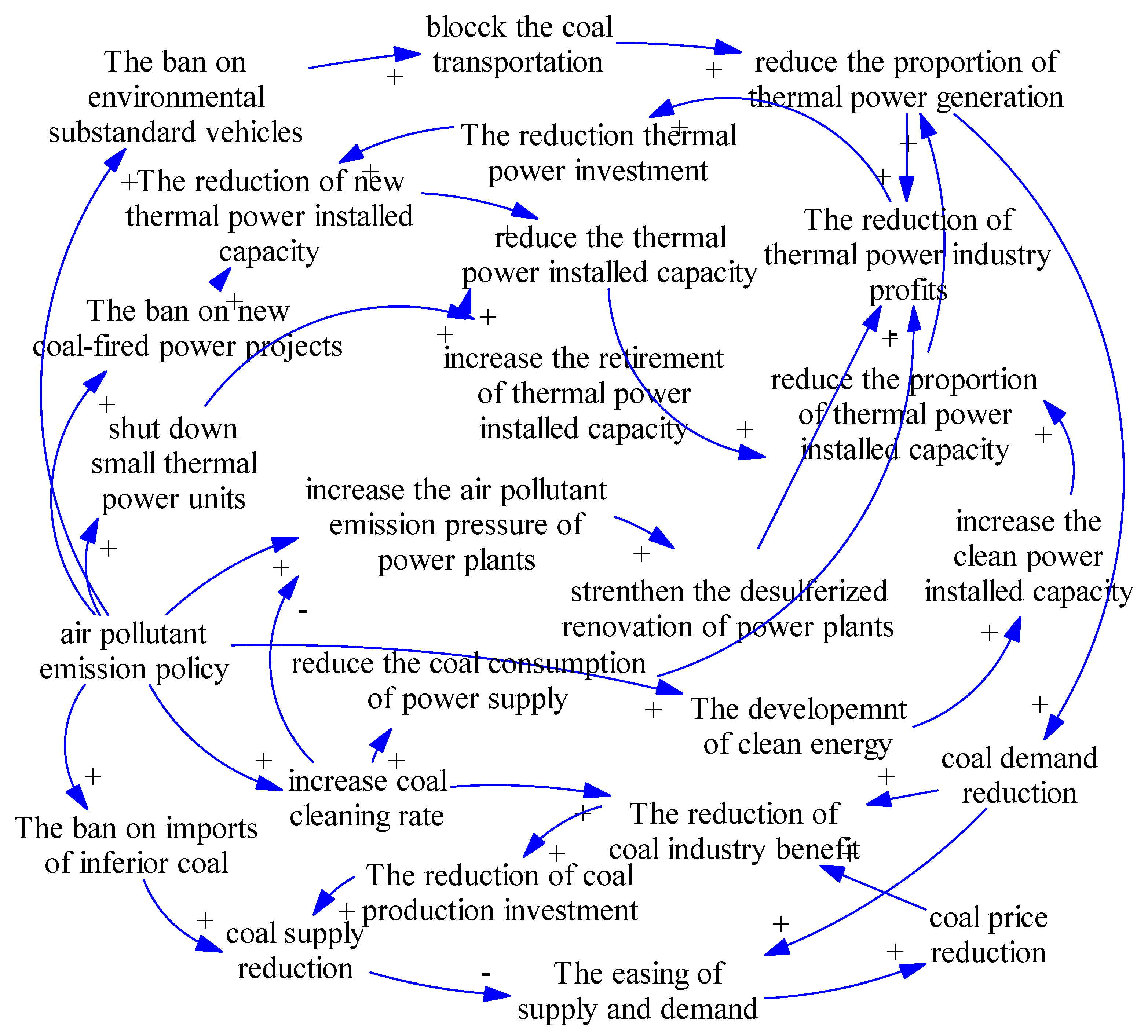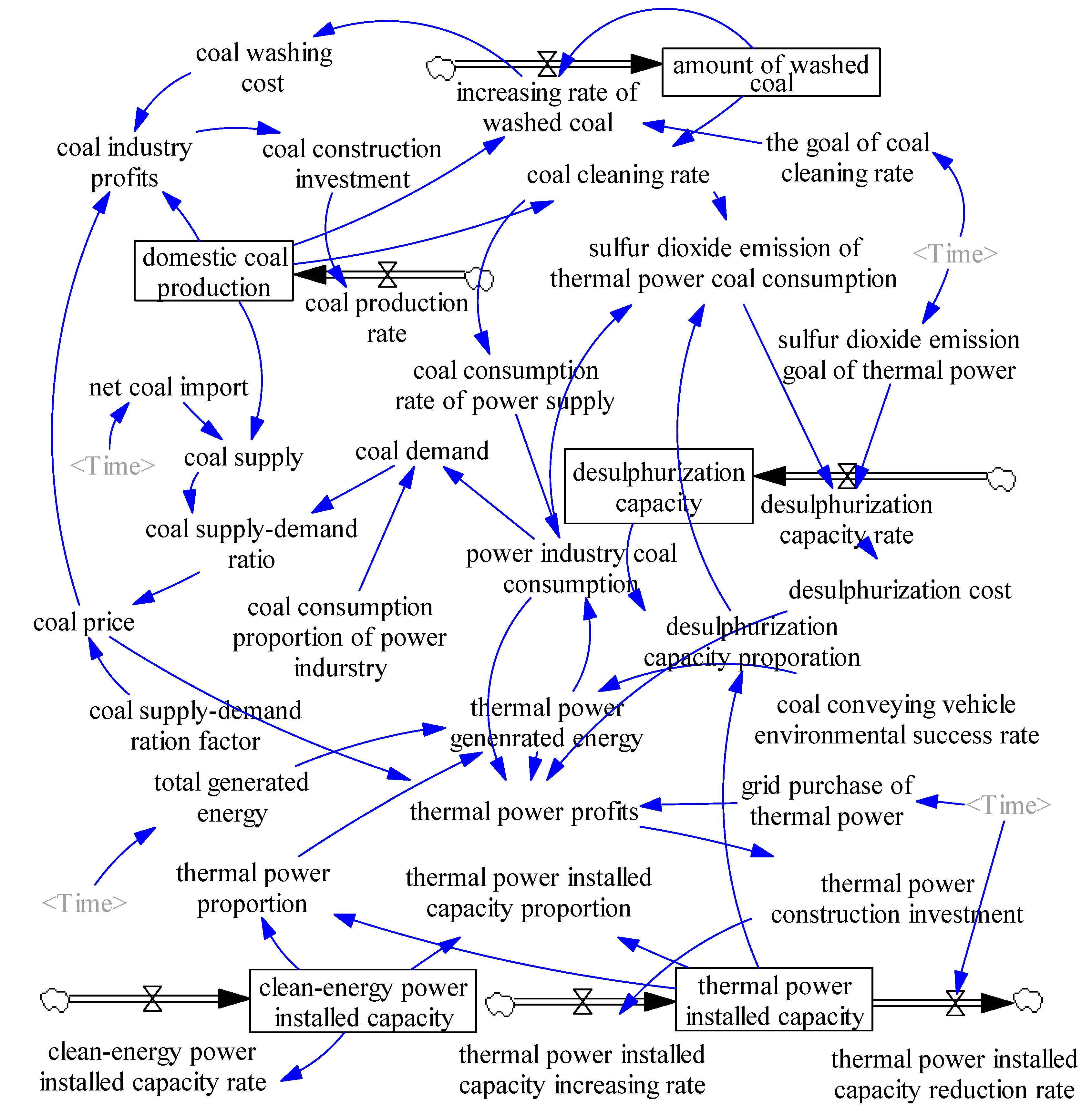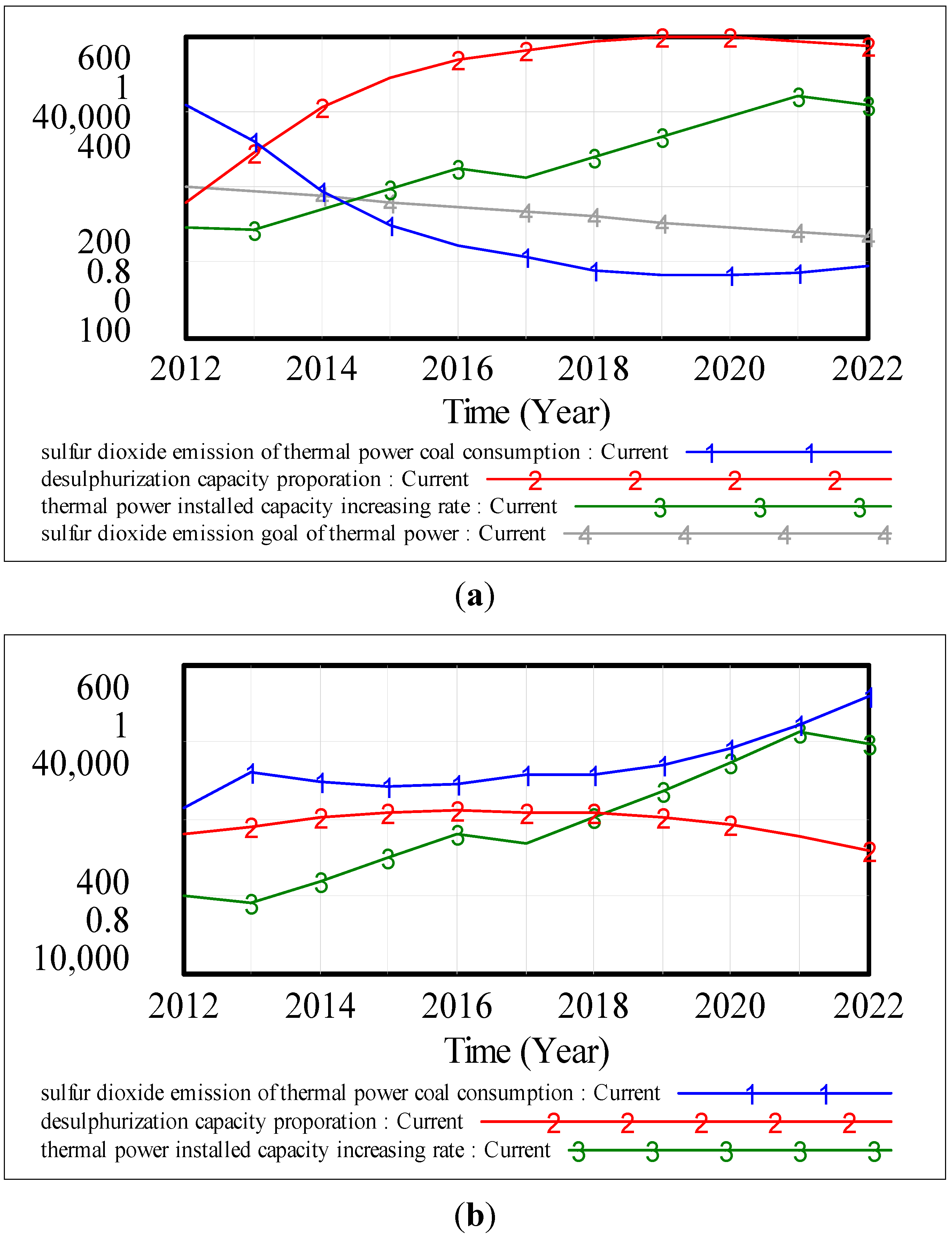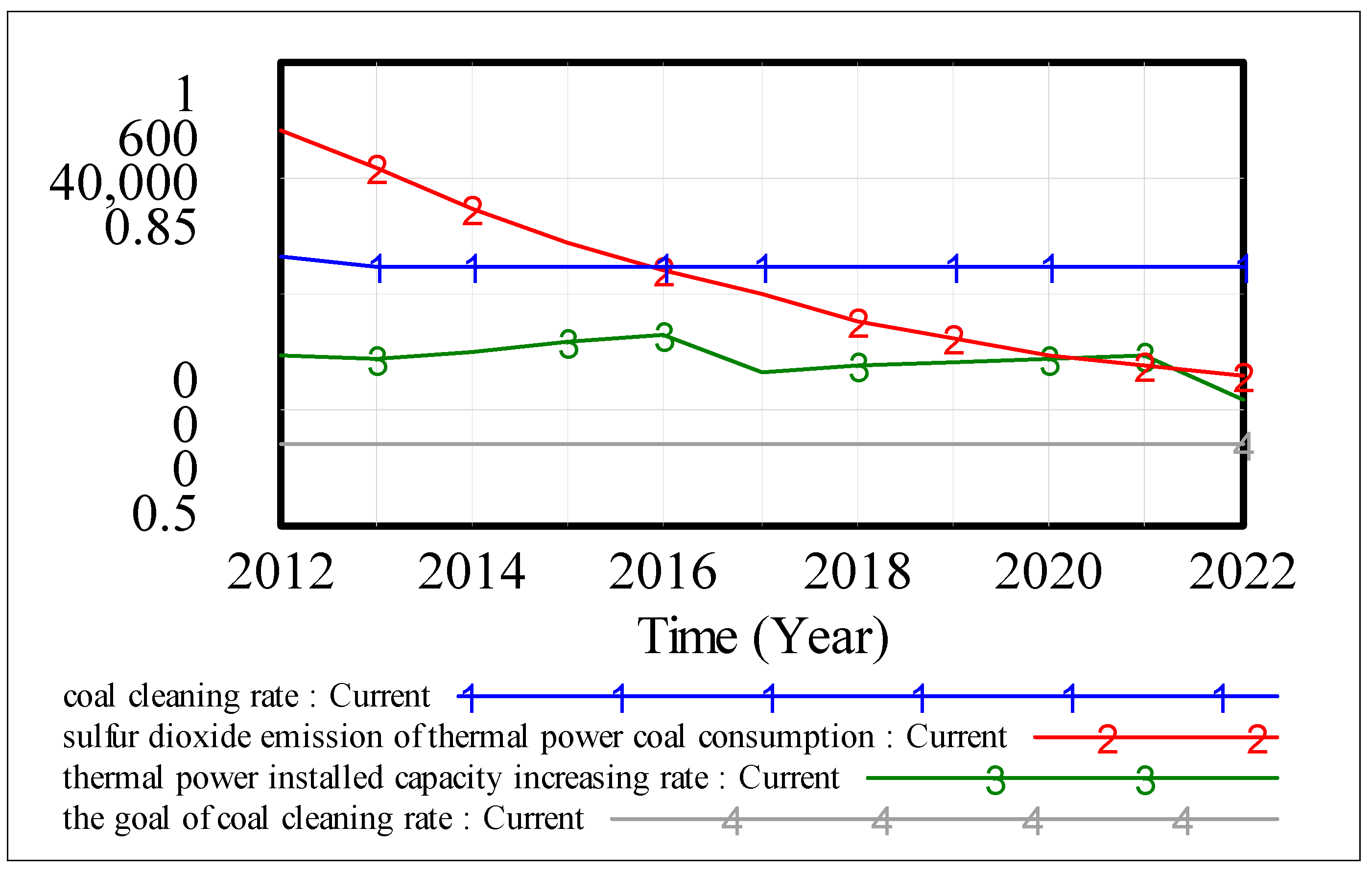Impact Analysis of Air Pollutant Emission Policies on Thermal Coal Supply Chain Enterprises in China
Abstract
:1. Introduction
- (1)
- To analyze China’s recent air pollution reduction policies systematically.
- (2)
- To apply some descriptive and effective methodologies to simulate the fundamental and dynamic development process of thermal coal supply chain member enterprises driven by emission reduction policies.
- (3)
- Taking China as a case study, to develop a system dynamics model based on Vensim PLE for Windows Version 5.10a software (Ventana Systems, Inc., Cambridge, MA, USA), which offers a realistic platform for predicting the development trends of China’s thermal coal supply chain enterprises from 2012 to 2022.
2. China’s Air Pollution Emission Reduction Policies
3. A System Dynamics Model of Policy Impact on Thermal Coal Supply Chain Member Enterprises
3.1. System Dynamics Methodology
3.2. Model Structure Analysis
3.2.1. Industrial Structure Adjustment
3.2.2. Energy Structure Adjustment
3.2.3. Technical Renovation
3.2.4. Market Mechanism Adjustment
3.2.5. Vehicle Environmental Management

3.3. Model Design

| Variable Category | Variable Name | Initial Value | Unit |
|---|---|---|---|
| state variable | amount of washed coal | 205,000 | 104 Ton |
| auxiliary variable | coal washing cost | - | 108 Yuan |
| rate variable | increasing rate of washed coal | - | 104 Ton |
| auxiliary variable | proportion of washed coal | - | - |
| auxiliary variable | proportion goal of washed coal | - | - |
| auxiliary variable | coal industry profits | - | - |
| auxiliary variable | coal construction investment | - | 108 Yuan |
| state variable | domestic coal productions | 357,357 | 104 Ton |
| rate variable | coal production change rate | - | 104 Ton |
| auxiliary variable | net coal import volume | - | 104 Ton |
| auxiliary variable | coal supply | - | 104 Ton |
| auxiliary variable | coal demand | - | 104 Ton |
| auxiliary variable | coal supply/demand ratio | - | - |
| auxiliary variable | coal supply/demand ration factor | - | - |
| auxiliary variable | coal price | - | Yuan/Ton |
| auxiliary variable | coal consumption proportion of power industry | - | - |
| auxiliary variable | coal consumption of power supply | - | g/KWH |
| state variable | thermal power installed capacity | 819,000 | MW |
| rate variable | thermal power installed capacity increasing rate | - | MW |
| rate variable | thermal power installed capacity reduction rate | - | MW |
| state variable | clean-energy power installed capacity | 323,940 | MW |
| rate variable | clean-energy power installed capacity change rate | - | MW |
| auxiliary variable | total generated energy | - | 108 KWh |
| auxiliary variable | thermal power generated energy | - | 108 KWh |
| auxiliary variable | proportion of thermal power generation | - | - |
| auxiliary variable | proportion of thermal power installed capacity | - | - |
| auxiliary variable | thermal power generation profits | - | 108 Yuan |
| auxiliary variable | thermal power construction investment | - | 108 Yuan |
| auxiliary variable | grid purchase of thermal power | - | Yuan/KWH |
| auxiliary variable | power industry coal consumption | - | 104 Ton |
| auxiliary variable | sulfur dioxide emissions of thermal power coal consumption | - | 104 Ton |
| auxiliary variable | sulfur dioxide emission goal of thermal power coal consumption | - | 104 Ton |
| state variable | desulfurization capacity | 753,480 | MW |
| rate variable | desulfurization capacity changing rate | - | MW |
| auxiliary variable | proportion of desulfurization capacity | - | - |
| auxiliary variable | desulfurization cost | - | 108 Yuan |
| auxiliary variable | coal-conveying vehicle environmental success rate | - | - |
4. Results and Discussion
4.1. The Impact of Sulfur Dioxide Emission Target Policy

4.2. The Impact of Coal Washing Proportion Target Policy


5. Conclusions
Acknowledgments
Author Contributions
Conflicts of Interest
References
- Xue, B.; Geng, Y.; Katrin, M.; Lu, C.; Ren, W. Understanding the Causality between Carbon Dioxide Emission, Fossil Energy Consumption and Economic Growth in Developed Countries: An Empirical Study. Sustainability 2014, 6, 1037–1045. [Google Scholar] [CrossRef]
- Frances, C.M. Climate Change and Air Pollution: Exploring the Synergies and Potential for Mitigation in Industrializing Countries. Sustainability 2009, 1, 43–54. [Google Scholar] [CrossRef]
- Zhao, X.; Ma, Q.; Yang, R. Factors influencing CO2 emissions in China’s power industry: Co-integration analysis. Energy Policy 2013, 57, 89–98. [Google Scholar] [CrossRef]
- Zhao, X.; Thomas, P.L.; Cui, S. Lurching towards markets for power: China’s electricity policy 1985–2007. Appl. Energy 2012, 94, 148–155. [Google Scholar] [CrossRef]
- Peggy, M.; Kenneth, B.K. Modelling tools to evaluate China’s future energy system—A review of the Chinese perspective. Energy 2014, 69, 132–143. [Google Scholar] [CrossRef]
- Liu, L.; Zong, H.; Zhao, E.; Chen, C.; Wang, J. Can China realize its carbon emission reduction goal in 2020: From the perspective of thermal power development. Appl. Energy 2014, 124, 199–212. [Google Scholar] [CrossRef]
- Tan, Z.; Zhang, H.; Shi, Q.; Xu, J. Joint optimization model of generation side and user side based on energy-saving policy. Electr. Power Energy Syst. 2014, 57, 135–140. [Google Scholar] [CrossRef]
- Cai, L.; Guo, J.; Zhu, L. China’s Future Power Structure Analysis Based on LEAP. Energy Sources Part A Recovery Util. Environ. Eff. 2013, 35, 2113–2122. [Google Scholar] [CrossRef]
- Zheng, M.; Zhang, K.; Dong, J. Overall review of China’s wind power industry: Status quo, existing problems and perspective for future development. Renew. Sustain. Energy Rev. 2013, 24, 379–386. [Google Scholar] [CrossRef]
- Hirota, K. Comparative Studies on Vehicle Related Policies for Air Pollution Reduction in Ten Asian Countries. Sustainability 2010, 2, 145–162. [Google Scholar] [CrossRef]
- Cai, W.; Wang, C.; Zhang, Y.; Chen, J. Scenario analysis on CO2 emissions reduction potential in China’s electricity sector. Energy Policy 2007, 35, 6356–6445. [Google Scholar] [CrossRef]
- Mathews, A.J.; Tan, H. The transformation of the electric power sector in China. Energy Policy 2013, 52, 170–180. [Google Scholar] [CrossRef]
- Wen, Z.; Li, H. Analysis of potential energy conservation and CO2 emissionsreductionin China’s non-ferrous metals industry from a technology perspective. Int. J. Greenh. Gas Control 2014, 28, 45–56. [Google Scholar] [CrossRef]
- Wang, K.; Wang, C.; Lu, X.; Chen, J. Scenario analysis on CO2 emissions reduction potential in China’s iron and steel industry. Energy Policy 2007, 35, 2320–2335. [Google Scholar] [CrossRef]
- SheikhiFini, A.; Parsa Moghaddam, M.; Sheikh-El-Eslami, M.K. A dynamic model for distributed energy resource expansion planning considering multi-resource support schemes. Electr. Power Energy Syst. 2014, 60, 357–366. [Google Scholar] [CrossRef]
- Zhu, H.; Huang, G. Dynamic stochastic fractional programming for sustainable management of electric power systems. Electr. Power Energy Syst. 2013, 53, 553–563. [Google Scholar] [CrossRef]
- Salman, A.; bin Razman, M.T. Using system dynamics to evaluate renewable electricity development in Malaysia. Renew. Electr. Dev. 2013, 43, 24–39. [Google Scholar]
- Li, L.; Sun, Z. Dynamic Energy Control for Energy Efficiency Improvement of Sustainable Manufacturing Systems Using Markov Decision Process. Cybern. Syst. 2013, 43, 1195–1205. [Google Scholar]
- Garcia, E.; Mohanty, A.; Lin, W.; Cherry, S. Dynamic analysis of hybrid energy systems under flexible operation and variable renewable generation-Part II: Dynamic cost analysis. Energy 2013, 52, 17–26. [Google Scholar] [CrossRef]
- Santiago, M.; Luis, J.M.; Felipe, B. A system dynamics approach for the photovoltaic energy market in Spain. Energy Policy 2013, 60, 142–154. [Google Scholar] [CrossRef]
- Ali, K.; Mustafa, H. Exploring the options for carbon dioxide mitigation in Turkish electricpower industry: System dynamics approach. Energy Policy 2013, 60, 675–686. [Google Scholar] [CrossRef]
- Feng, Y.; Chen, S.; Zhang, L. System dynamics modeling for urban energy consumption and CO2 emissions: A case study of Beijing, China. Ecol. Modell. 2013, 252, 44–52. [Google Scholar] [CrossRef]
- Li, F.; Dong, S.; Li, Z.; Li, Y.; Wan, Y. The improvement of CO2 emission reduction policies based on system dynamics method in traditional industrial region with large CO2 emission. Energy Policy 2012, 51, 683–695. [Google Scholar] [CrossRef]
- Nastaran, A.; Abbas, S. A system dynamics model for analyzing energy consumption and CO2 emission in Iranian cement industry under various production and export scenarios. Energy Policy 2013, 58, 75–89. [Google Scholar] [CrossRef]
- Özer, B.; Görgün, E.; Incecik, S. The scenario analysis on CO2 emission mitigation potential in the Turkish electricity sector: 2006–2030. Energy 2013, 49, 395–403. [Google Scholar] [CrossRef]
- Frederick, A.A.; David, O.Y.; Alex, A.P. A Systems Dynamics Approach to Explore Traffic Congestion and Air Pollution Link in the City of Accra, Ghana. Sustainability 2010, 2, 252–265. [Google Scholar] [CrossRef]
- Lin, B.Q.; Moubarak, M. Renewable energy consumption—Economic growth nexus for China. Renew. Sustain. Energy Rev. 2014, 40, 111–117. [Google Scholar] [CrossRef]
- Bloch, H.; Rafiq, S.; Salim, R. Economic growth with coal, oil and renewable energy consumption in China: Prospects for fuel substitution. Econ. Modell. 2015, 44, 104–115. [Google Scholar] [CrossRef]
- Shen, J.F.; Xue, S.; Zeng, M.; Wang, Y.; Wang, Y.J.; Liu, X.L.; Wang, Z.J. Low-carbon development strategies for the top five power generation groups during China’s 12th Five-Year Plan period. Renew. Sustain. Energy Rev. 2014, 34, 350–360. [Google Scholar] [CrossRef]
- Weller, F.; Cecchini, L.A.; Shannon, L.; Sherley, R.B.; Robert, J.M.; Altwegg, R.; Scott, L.; Stewart, T.; Jarre, A. A system dynamics approach to modelling multiple drivers of the African penguin population on Robben Island, South Africa. Ecol. Modell. 2014, 277, 38–56. [Google Scholar]
- Jose, B.C.; Tan, R.R.; Culaba, A.B.; Ballacillo, J.A. A dynamic input–output model for nascent bioenergy supply chains. Appl. Energy 2009, (Suppl. 1), S86–S94. [Google Scholar]
- Haghshenas, H.; Vaziri, M.; Gholamialam, A. Evaluation of sustainable policy in urban transportation using system dynamics and world cities data: A case study in Isfahan. Cities 2014, in press. [Google Scholar]
- Mao, X.Q.; Zeng, A.; Hu, T.; Xing, Y.K.; Zhou, J.; Liu, Z.Y. Co-control of local air pollutants and CO2 from the Chinese coal-fired power industry. J. Clean. Prod. 2014, 67, 220–227. [Google Scholar] [CrossRef]
- Wang, S.; Xu, L.; Yang, F.L.; Wang, H. Assessment of water ecological carrying capacity under the two policies in Tieling City on the basis of the integrated system dynamics model. Sci. Total Environ. 2014, 472, 1070–1081. [Google Scholar] [CrossRef] [PubMed]
- Rehan, R.; Knight, M.A.; Unger, A.J.A.; Haas, C.T. Financially sustainable management strategies for urban wastewater collection infrastructure–development of a system dynamics model. Tunnell. Undergr. Space Technol. 2014, 39, 116–129. [Google Scholar] [CrossRef]
- Bollen, J.; Brink, C. Air pollution policy in Europe: Quantifying the interaction with greenhouse gases and climate change policies. Energy Econ. 2014, 46, 202–215. [Google Scholar] [CrossRef]
- Kanada, M.; Fujita, T.; Fujii, M.; Ohnishi, S. The long-term impacts of air pollution control policy: Historical links between municipal actions and industrial energy efficiency in Kawasaki City, Japan. J. Clean. Prod. 2013, 58, 92–101. [Google Scholar] [CrossRef]
© 2014 by the authors; licensee MDPI, Basel, Switzerland. This article is an open access article distributed under the terms and conditions of the Creative Commons Attribution license (http://creativecommons.org/licenses/by/4.0/).
Share and Cite
Guo, X.; Guo, X.; Yuan, J. Impact Analysis of Air Pollutant Emission Policies on Thermal Coal Supply Chain Enterprises in China. Sustainability 2015, 7, 75-95. https://doi.org/10.3390/su7010075
Guo X, Guo X, Yuan J. Impact Analysis of Air Pollutant Emission Policies on Thermal Coal Supply Chain Enterprises in China. Sustainability. 2015; 7(1):75-95. https://doi.org/10.3390/su7010075
Chicago/Turabian StyleGuo, Xiaopeng, Xiaodan Guo, and Jiahai Yuan. 2015. "Impact Analysis of Air Pollutant Emission Policies on Thermal Coal Supply Chain Enterprises in China" Sustainability 7, no. 1: 75-95. https://doi.org/10.3390/su7010075
APA StyleGuo, X., Guo, X., & Yuan, J. (2015). Impact Analysis of Air Pollutant Emission Policies on Thermal Coal Supply Chain Enterprises in China. Sustainability, 7(1), 75-95. https://doi.org/10.3390/su7010075





